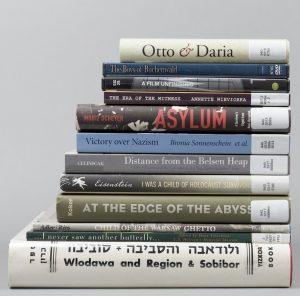Holocaust organizations around the world are preparing for a future of Holocaust education and research in a post-eyewitness era. Some collecting institutions are also experiencing higher volumes of donations of artefacts, documents, photographs and book collections from Holocaust survivors and their families as Holocaust survivors age. The Vancouver Holocaust Education Centre (VHEC), a teaching museum devoted to Holocaust-based anti-racism education, is in a period of reorientation amidst this reality.
To meet these challenges, the VHEC needed a robust collections management system (CMS) to properly steward and extend the reach of its collection. After nearly four years of work, the VHEC launched its publicly-accessible CMS this past April. The result is a relational, open-source database powered by CollectiveAccess that pulls together the Centre’s survivor testimony, archival, museum and library collections.
Collections staff started the CMS project in 2014, in the same year that the VHEC began a major project to digitize over 200 audio-visual survivor testimonies and other primary sources from the VHEC collection.[1] At the outset, Collections staff envisioned a sustainable CMS that would responsibly manage digital files and treat all four of the Centre’s collection areas (survivor testimonies, archives, museum and library) holistically. It was untenable to continue with the Centre’s proprietary databases that kept collection areas separate and were searchable only by staff. For inspiration, Collections staff looked to the VHEC’s community of Holocaust survivors and their families, members, donors, researchers, teachers and students and asked what functionality the CMS had to have to better serve this community. In addition to bringing together and relating the four collection areas, Collections staff hoped the CMS would reveal rich relationships between objects, entities, exhibitions, places, historical events, topics, teaching resources and more. If these relationships could be established in the CMS, they would benefit VHEC staff who produce thematic exhibitions, school programs and teaching materials as well as front-end users of the system who seek information about the Holocaust for educational and research purposes.
To realize this vision, the CMS project team expanded to include contract workers and external advisors with expertise in archives, libraries, museums, metadata, digital preservation and information technology. After carefully reviewing several fixed proprietary systems and more customizable open-source systems, the team settled on CollectiveAccess, the open-source collections management and presentation software created by Whirl-i-Gig in New York. Initially, the team thought an open-source system would not be feasible because the VHEC didn’t have adequate IT support to develop and maintain it. When it became clear, however, that none of the proprietary systems could accomplish what the team wanted them to, the VHEC committed funding to engage Whirl-i-Gig to develop the Centre’s CollectiveAccess build. The VHEC also increased the level of IT support at the Centre. 
The CMS project team was keen to join the open-source CollectiveAccess community. The possibility of sharing the VHEC’s investment in an innovative and experimental CollectiveAccess build with other cultural heritage institutions, which often face funding fluctuations, appealed to everyone. At the time, no one on the team was aware of another system that worked well for mixed collections like the VHEC’s. The VHEC benefitted from the Vancouver Maritime Museum’s early adoption of CollectiveAccess and was later able to contribute components of the VHEC’s build to the Indian Residential School History and Dialogue Centre at UBC.
The CMS project team’s cross-collections collaborative approach was not without its challenges. It wasn’t always easy to break down the barriers of archival, library and museum training, standards and practices. The team members strived to learn from each other and worked together to recognize the strengths and weaknesses of each information discipline. The librarians on the team could share information about making resources widely accessible and presenting clear and meaningful data to end users (a lesson learned from the Resource Description and Access descriptive cataloguing standard). At the same time, the librarians had much to learn from their archivist and museum colleagues about data aggregation and contextualization, access protocols (including rights and permissions), digital preservation, provenance research, and online exhibition development and displays. There were lively and productive discussions and debates as the project team worked together to craft the metadata schemata and controlled vocabularies.
As a result of this hard work, front-end users can engage with the VHEC’s collection in a whole new way. A researcher can perform a keyword search for “Warsaw Ghetto,” and retrieve relevant survivor testimonies, archival documents and photographs, museum objects, and rare books and other publications. The relationships in the database further enrich the search experience for users. A teacher who lands on the library record for Lillian Boraks-Nemetz’s The Old Brown Suitcase will discover links to related holdings (including The Sunflower Diary, The Lenski File, the French-language Slava, a teaching resource for the book, and a classroom book set), related people and organizations (notably the author’s entity record that leads to clips from her survivor testimonies) and related places (the Warsaw Ghetto and Montreal). Students, researchers and other system users have the option of using a “Lightbox” feature to create, share and download their own collections of items selected from the CMS.
Although the formal CMS project is now complete, Collections staff (contracted back to the original makeup of one Registrar, one Archivist and one Librarian) are still populating the system and turning their attention to educating users about the CMS. A CMS orientation event will take place this fall for teachers, and other training occurs on an individual basis in response to reference requests. This work is happening in the VHEC’s newly renovated facilities (the result of the Centre’s Renewal Project) and adjacent to the Centre’s inaugural exhibitions in the new space, In Focus: The Holocaust Through the VHEC Collection and Faces of Survival: Photographs by Marissa Roth.
The VHEC’s recent investments in infrastructure and technology, including the CMS, leave the Centre well-positioned to meet the challenges of Holocaust education and research in the post-eyewitness era. The VHEC hopes the CMS and the access it provides to primary sources and related holdings will allow the Centre to reach new audiences and even more students than the 25,000 it already engages annually. This leap into the digital world ensures that the VHEC will be able to carry on Holocaust survivors’ commitment to education and remembrance of the Holocaust well into the future.
The digitization of the VHEC’s collections and the development of the CMS was made possible by a generous donation on behalf of the Paul and Edwina Memorial Fund through the Greater Vancouver Jewish Community Foundation. For more information about the VHEC, the CMS project, the Centre’s Renewal Project and current exhibitions please visit vhec.org or view the latest issue of the VHEC’s Zachor publication (Spring 2018), available at: vhec.org/images/pdfs/Zachor_Spring2018.pdf.
[1]This digitization project was funded by Citizenship and Immigration Canada’s Inter-Action program.
—
Shannon LaBelle is the Librarian at the Vancouver Holocaust Education Centre.
Photographs by Katie Powell.


